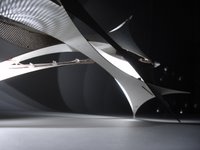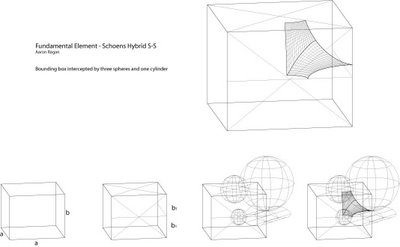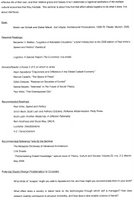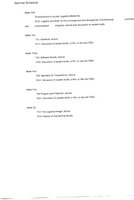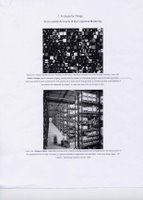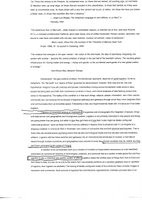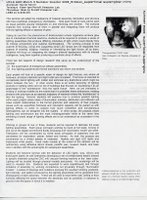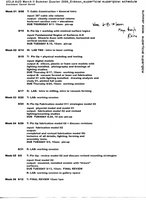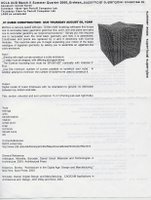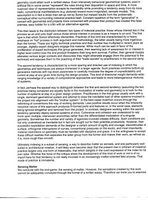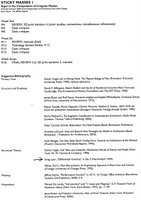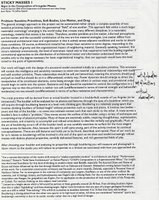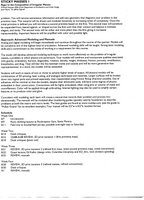Below is an essay by the professor for an upcoming reissue of Paul Virilio's Speed of Politics:
Logistics of Habitable Circulation
A brief introduction to the 2006 edition of Speed and PoliticsBenjamin H. Bratton
“If there had never been a war, I would have made a very good architect.”
--Ahmed Shah Masoud, Afghan opposition leader reportedly assassinated 9.9.01 by suicide bombers who were, it is assumed, trained by Osama Bin-Ladan on behalf of the Taliban, as quoted in the Los Angeles Times, the morning edition of September 11, 2001.
Paul Virilio’s Modernity is logistical. It doesn’t directly deal with war, but with everything that makes it possible. Logistics is the preparation for war through the transfer of the nation’s potential to its armed forces in time of peace as in times of war. [Pure War, 16] Modernity is a world in motion, expressed in translations of strategic space into logistical time, and back again. It is a history of cities, partitions, trading circuits, satellites, and software; of a political landscape governed by competing technologies of surveillance, mobilization, fortification and their interdependent administrations. It begins as an archaelogy of naval routes, strategic techniques and urban distributions, and becomes an integrated world of events reduced to shapes and symbols, viewed and manipulated instantaneously on screens. In Virilio’s narrative, architectural regimes become computational, and vice versa. Both are logistical media for mobilization and its administration, technologies that consolidate territory into logistical fields and enable a Modern governance based on the abstracted calculation over omnidirectional spaces and surfaces, from open oceans to shared spreadsheets. This comprehensive technologization of the globe signals for Virilio both integration and disintegration, both control and accident. And it is finally through the accident, the realization of the imminent, irreducible risk that logistics hopes to contain, and not through control, that the strongest bonds of the polis are formed. For Virilio, they are an exceptional condition already contained within, and rigorously predicated by the invention that made them possible.
In the 1960’s, Virilio collaborated with architect Claude Parent to develop a challenging program for an oblique architecture using inclined planes. It followed the principle of “habitable circulation,” intending to radically expand the usable surface of urban landscape. His work as a theorist from the mid-1970’s to today can be seen as a retroactive thesis on the possibility of such an architecture, and an ultimate abandonment of it in the face of other emerging spatial media. “The focus of my research,” Virilio noted, “has shifted from topology to dromology, i.e., the study and analysis of the increasing speed of transport and communications on the development of land-use.”
[i] The image of the ‘polis’ (city) as a dynamic, vehicular landscape is both Virilio’s initial architectural solution and his eventual theoretical warning. “Dromology” (from Gr. dromos: race course) is this government of differential motility, of harnessing and mobilizing, incarcerating and accelerating things and people. His third book, Vitesse et Politique/ Speed and Politics (1977, 1986, 2006) is a history of what he calls an “inevitable technological vitalism” through which multiple projectiles—the inert membranes of fortress and bunkers, the “metabolic bodies” of soldiers, and transport bodies of naval vessels—mutually prostheticize each other in a pursuit of the competitive advantage of speed.
[ii] Among the key metabolic transformations traced in the book is the movement from the urban fortress to the open, smooth glacis of the sea, now a “vast logistical camp” in which naval, and finally amphibious strategies organize a “right to the sea.” This in turn framed a “right to the road” and later diagrammed the land in the smooth image of maritime drift. In that shift, the condition of habitable circulation, and its origins in military logistics - mobilization and fortification - remains of critical importance. What was once asked of architecture, though, is now accomplished by other means, both informational and computational. Now the presence and vehicular movement of people and objects through global space is tightly integrated with an infrastructure of software, and to send objects in motion or to impede their trajectory is a logistical labor performed by pulses of light as much as flesh and steel.
“...An Essay on Dromology”
Speed and Politics was first published in Paris against a backdrop characterized by the complicit, symmetrical stand-off of nuclear superpowers sealed by the SALT II accords, as well as by the rise of political terrorism in London, Rome, Mogadishu, Stammheim, Phnom Penh, Palestine, etc. By then, May 1968 (to which Virilio owed his appointment as Director of the École Speciale d’Architecture) had soured into a restless, if also fertile, malaise. A new French society was reconfiguring itself around audiovisual media: the kitsch utopia of Beaubourg, the commercial center buried underneath the Forum des Halles, the new information headquarters at La Défense, followed by the nightly spectacles at Bercy. Perhaps this had to be expected. Didn’t Mai end with a dour Pres. de Gaulle going on television, instead of appearing in person on the balcony of the Hôtel de Ville, as would have been the custom? The anti-climactic broadcasts managed to accomplish through the single-channel television something no urban strategy could have done: to stop the tumult of the deterritorialized streets, and to bring the nation if not to order, then to attention, to fix their gazes on a new national center not of buildings but of screens. Virilo’s work from this period can be understood as a sort of immediate pre-history of the “Software Society.”
[iii] By 1986, and the time of this English translation, the problematics of information technology, computational technologies (particularly database and optical media) had displaced the city (it reappeared in his later work, but as a artifact of the media that had partially consumed its earlier functions).
Virilio’s logistical Modernity is meant to “to carve and guide the masses,” the metabolic multitude, into mobile trajectories. Dromology is a shifting, restless logistics of differential governance transforming the raw material of the world and rendering it “in a more appropriate form.” (10)
For Virilio, “the city is but a stopover, a point on a the synoptic path of a trajectory, the ancient military glacis, ridge road, frontier or riverbank, where the spectator’s glance and the vehicle’s speed of displacement were instrumentally linked… There is only habitable circulation” (6). Cities accelerate and/or frustrate these multiple scales of relative object velocity. They are “uncertain places because they are situated between two speeds of transit, acting as brakes against the acceleration of penetration.” (8) As a technology of space, cities galvanize both human and non-human metabolisms, channeling them, amplifying them, concentrating them into centers, domesticating them into suburbs. The question that would animate much of Virilio’s subsequent work is: how have these core functions of the city been assumed by other dromological media?
Our Logistical Modernities
“History progresses at the speed of its weapons systems;” that is, at the speed of the competitive capacities to envision, draw, map, curtail, mobilize, contour, stabilize and police the polis. (68) At least since Vitruvius defined the rules of architecture based on his own military engineering experience, it is understood that the design of space is already a strategic weapon of fortification. But architectural media are only one such means and the evolution of their deployments is interrelated and serpentine. Marquis de Vauban, Louis XIV’s chief military engineer of fortifications (and of their breaching,) made to his king the unusual recommendation that he should voluntarily cede contested land deemed “indefensible.” The plan realized Richelieu’s earlier image to France as “le pré carré,”or the “squared field,” and in fact this same phrase was later used to describe Vauban’s parallel lines of fortifications up and down the now consolidated national enclosure. In 1782, Charles de Fourcroy’s tableau poliometrique appeared. This “first known flowchart” is a diagram of the relative sizes of European metropoles, and in it, as geographer Gilles Palsky notes, “we see the passage to abstract, to fictitious features. By these proportional triangles, (de Fourcroy) constructs an image that does not return or relate to (the) original existence.”
[iv] De Fourcroy’s semiotic innovation was this figural territorialization, the drawing of the comparative scale of cities as relative, primary geometric forms. This “map” does not correspond to any direct representation of the geographic juxtaposition of the cities, but rather graphs their relative quantitative difference in population. This inscription produces another virtual space with which to order the natural territory of the polis as a projected image of an enclosed, administrative totality.
For Virilio, this also signals the production of logistical space as a Modern administrative horizon. “This means the universe is redistributed by the military engineers, the earth ‘communicating’ like a single glacis, as the infra-structure of future battlefield,” (51) not one limited by given terrestrial geography. With the French Army of Engineers being assigned the task in 1790 of “expand(ing) the logistical glacis over the whole territory,” this era marked the birth of Modern administration-by-calculation, an on-going project in which all of the vicissitudes of land and its inhabitants are continuously charted, symbolized, and manipulated. Virilio locates its emergence in the history of military geography, especially naval techniques. “Total war is omnipresent; it is first waged on the sea because the naval glacis naturally presents no permanent obstacle to vehicular movement of planetary dimensions,” and the mobility of smooth maritime space would return to organize land in its logistical image. (50) Governance by speed (by states or otherwise) is logistics, and logistics, like the oceanic vectors from which it is born, is omnidirectional.
Today the speed of logistics is also largely computational, but this is not to say virtual, immaterial, or distant. Quite the contrary. Supermarket shelves, for example, are a human interface to a vast internet of things: a network of supply-chain, demand-chain and customer-relationship management softwares, steel containers, offshore factories, inter-modal exchange protocols—all forming an unimaginably complex, robust and nimble assembly of everyday purchase commands with vast economies of production and distribution. Today’s “fleets-in-being” are the exabytes and gigatons of component inventories in permanent transit, hurtling between trade zones as the consumable artifacts of their sponsoring corporations’ technological and legal efficiencies. Finally, these (disin)corporations and their far-flung suppliers of parts, labor, and expertise, guard nothing so dearly as the legal agency of brands, those operational fictions which they so carefully embed into the demographically-microsegmented experiential touch-points of everyday life. This “flat world” imagines itself as slippery, oceanic grid modulated by differentially transporting, activating, internalizing, and/or prophylactically exteriorizing technologies: from shipping ports to aerotropoli, from banking software GUIs (graphical user interfaces) to web browser layout engines and data security protocols. Like an Andreas Gursky photograph, this “frictionless” landscape of interconnected objects and subjects is the constitution of a new architecture, one that relies on fragile alibis of virtual immateriality and procedural transparency to achieve the political, economic efficacy it enjoys. The reality of its performance, however, is also a uncontrollable accumulation of (very real and opaque) unintended consequences.
Dromocracy: Government by Prosthetics
Where does Virilio locate the historical agency of dromology (speed) and dromocracy (politics) ? How does one become the other? The recurring actor in Virilio’s history is the State, if only because it is also the legal signatory of modern war. But his is hardly a traditional political theory. “In fact there is no “industrial revolution” but only a “dromocratic revolution”; there is not democracy, only dromocracy; there is not strategy, only dromology.” (46) States employ dromological techniques to exercise power, but as for Foucault, state apparatuses are functions, artifacts even, of dromocratic machinations that exceed their constitutions and incorporations. For Virilio (in concert with Deleuze and Guattari) such state governments are profiled as a sort of “machinic species” of collective formation. Echoing Heidegger, he writes that “dromocratic intelligence is not exercised against a more or less determined military adversary, but as a permanent assault on the world, and through it, on human nature. “ (64) Likewise, the mobilization of economic production is characterized less in terms of maximizing surplus labor value than according to the distribution of metabolic intensification in the service of an historically comprehensive acceleration.
Dromocracy establishes and reproduces standardized forms of assembly and disassembly for the systematic integration of human energy into specific infrastructure. “Factory work must not escape the dictatorship of movement. It reproduces the enclosure on the spot, in the obligatory and absurd kinetic cycle…a condensed machine of the logistical glacis. ” This is the design of corporeal discipline in the pursuit of the image of speed (not the image of truth as Foucault might prioritize it) in which “the class struggle is replaced by the struggle of the technological bodies of the armies according to their dynamic efficiency: logistics” (49). Indeed the exercise of political authority in and through the dimensions of the body-in-motion appears for Virilio in its most extreme and comic form in those performances of collective singularization that are Marxist state stadium pageants. Their choreographies of motor functions move according to the party line, now a literal grid. The numb aesthetic of “miming the joys at being liberated” and through this, “the simplicity of a power that comes down to the constraint and housebreaking of bodies,” is repeated upside down in the camps where the misbeliever’s body absorbs the cultivation of the law. (32) Virilio writes, “his dissidence is a postural crime” (33). Even today, as this script of fleshly discipline has largely been exported from the commanding G8 metropoles to its satellites, another softer intercourse emerges between the individual and his logistical destiny, transposed into other symbolic and informational economies.
Dromocracy depends on technologies that straddle the pre-political and the hyperpolitical, working on the bodies of the masses as a practical material that can be strategically designed and deployed. If the city is a collective prostheses of its inhabitants, other technologies are for a more individual, specific purpose, for example the car. “The transportation capacity created by the mass production of automobiles became a social assault on space” that would undo centripetal urban concentration exploding it into the congested network of the open highway. (26) “No more riots, no need for much repression; to empty the streets, it’s enough to promise everyone the highway: this is the aim of (the Nazi party’s) Volkswagen plebiscite.” (25) Dromocracy extends to this new platform: “speed limits…we are talking about acts of government, in other words of the political control of the highway, aiming precisely at limiting the extraordinary power of assault that the motorization of the masses creates.” (27) Earlier in the century, the concentration of industrial technology into individual motorized locomotion had already revolutionized the battlefield in the figure of the tank, that “automotive fort.” (56) These offered their commanders a new calculus of speed and movement. As if sailing across a smooth surface, the tank “extends war over an earth that disappears, crushed under the infinity of possible trajectories.” (56) Virilio suggests these “battleships of earth” (57) should not be called “all-terrain,” but “sans-terrain” in their obliteration of territorial impediment. Later with the Jeep (and more grotesquely the Hummer) the personal fortress would allow for the (largely pretentious) presumption of this power to the performance of the daily commute.
[v] But vehicular prostheticization is not only automotive. Others are assimilated as surgical prosthetics, others as fashion. The long marches of soldiers across fields plowed by battle during World War I presented the problem of damaged feet, and gave rise to the practical science of Orthopedics, and the redesign of the pedestrian soldiers locomotive technology: his shoes. This accomplishment is amplified and embellished in the cultural imaginary for which the sports shoe becomes a vehicle of personal ambulatory and logistical excellence (“just do it”).
The Information Bunker and the Ubiquitous Front
Today information is architecture by other means, framing and contouring the relative motility of social intercourse. While the city remains a locus of this staging and dissimulation of security, it is supplanted by other network media that have assumed some of its traditional mandates. Now highly evolved species of de Fourcroy’s tableau poliometrique proliferate on screens and surfaces in the form of the graphical user interfaces, narrating the affordances of the softwares they inscribe. But these GUI are not just diagrams of virtual action to be taken, they are also mechanisms through which a user’s motivation is first framed and then realized in the network and on the world. Modes of representation that were once cartographic and diagrammatic are now instrumental and mediational.
As the diagram becomes an interface, when the map becomes the tool, personal, individual social action becomes more logistical. The subjective manipulation of virtual symbols becomes a structural form of agency in this (pre-formatted) landscape of proximate and immediate contact. Consider how the political function of the urban gateway or boulevard to centralize and coordinate traffic and attention has been augmented by web portals and search engines, interfaces to the vast exabytes of online data curated and mainstreamed for public accessibility. There the preferences of mobs are codified in the ranking of search results associated with potential words, places and concepts. Search represents a new configuration of public tools with which to seek, browse, meander, and exchange files with others, to be proximate to others in your social networks. Not unlike cities themselves, Search is legislated by shifting balance of demographic desires, shareholder interest, and State paranoia. Virilio writes, “The State’s political power is...the polis, the police, in other words, highway surveillance.” (14). Indeed many core innovations in Search technology are sponsored by security interests (state and otherwise) needing to meaningfully sift petabytes of “chatter” from which intelligence critical to securing the polis might be gleaned.
Newer Search software works by making the world itself into the operant interactive metaphor for the world itself. Google Earth’s interactive map/search/data visualization software, borrowing its interface aesthetics from previous generations of satellite-image based battlefield simulation suites, promises to further incorporate personal logistics of everyday life into the tropics of “intelligence.” Its open API (application programming interface) also allows users to link Google Earth to other data streams, personal and public, furthering tipping the logic of its performance from that of a “map with interactive capabilities,” toward that of a real “meta-interface” based on cartographic, diagrammatic metaphors.
Just as diagrams become interfaces, computation also transforms physical urban interfaces by making them in turn increasingly diagrammatic. “In all parts of the world,...implanted at the edges of cities, highways or railways…. (is a) whole apparatus that is only the reconstitution of the various parts of the fortress motor, with its flankings, its gorges, its shafts, its trenches, admission to and escape from portals, the whole primordial control of the masses by organisms of urban defense.” Of the masses of things, that is. Today the urban interfaces of material exchange between supply chains and demand chains include ports of entry, now refitted as computationally-intensive logistics parks, which serve as regional switching mechanisms for the routing of components and the formation of geographically distributed assemblies of producers and consumers. There is a dromological heaven in these. The United Arab Emirates currently plans a truly Modern city of the future in their own in Jebel Ali, the Dubai Logistics City, which hopes to dwarf the strategic centrality of competing hubs in Rotterdam, Singapore, Shanghai and elsewhere by providing seemingly endless acreage of sea-air and air-air multi-modal passenger and cargo services: “merge-in-transit, customization, postponement, packaging and labeling, and final assembly.” Today our visionary architecture is designed not for the care and habitation of people, but as a utopia of and for objects.
Impure War and the Exceptional Accident
Virilio’s history- and our present moment- is a profile of violence, of both binding and fissure. While Virilio begins with the literal, primordial bunker, he extends the economy of attrition to characterize Modernity itself. The bunker and its double, the camp, are the elemental spaces of this. The bunker is a concrete prophylactic, the camp is incarcerating. Both are hygienic, defensive. One is an architectural membrane against a hostile world, and one is an expulsion-by-enclosure of the Other from the normal performance of law. In their extreme forms, both spaces, even as they are often architecturally identical, are in their way zones of pure logistics. They are sites where the only compulsion is the execution of governance on a raw mass, mobilizing it, diagramming it. They are only ideal types, and the real world is full of spaces (factories, airports, warehouses, laboratories, jails, shipping ports, etc.) that are complex combinations of the bunker and the camp, switching from one the other, inverting exteriorization and interiorization moment by moment.
For Virilio, the accumulation of capital is a means to ensure security, not the inverse. He writes: “Bourgeois power is military even more than economic, but it relates most directly to the occult permanence of the state of siege, to the appearance of fortified towns, those ‘great immobile machines’ made in different ways” (11). The competitive and complicit energies of the masses are understood as possessing a permanent poliorcetic historical mission (conducting or resisting sieges), and their movements are governed by the immobile surfaces of city, resolved in a suspended state of soft siege. This slow, permanent war is itself a technology of glacial attrition and shared deterrence. The city is in essence a bunker, characterized by Virilio as a deliberate “reduction of power in favor of a better trajectory, life traded for survival” (63). The “front” of this “pure war” is everywhere and everything, both inside and outside of the “closed world” of the “society of control.” The comprehensive enclosure of earthly territory under dromocratic supervision totalizes this soft siege as a condition of global social space. Today’s “security environment” (a preferred catch-phrase of Rumsfeld’s) is populated by a Poliorcetics Lite, in which the defense of common civilian passage from potential acts of violence is folded into design criteria for the dissuasion of both petty and grand crime.
[vi] But to be sure, Virilio’s core exhortation diverges from that offered by a “frictionless capitalism” and its ideologies of reflexive transparency and seamless control. Instead, he sees the cumulative destiny of dromological globalization as a successively violent, increasingly integrated history of accidents. This Ballardian depiction of technology suggests that the invention or adoption of a new technology is always also the invention and adoption of a new accident. The invention of the ocean liner is also the invention of its catastrophic sinking, the internal combustion engine is itself the invention of greenhouse gases, the discoveries of genomic science also bring with them the latent horrors of a “genetic bomb,” and the comprehensive integration of personal social lives into information networks is also their inevitable crash, taking with them the very social bonds that they contain and mediate for us. Such solutions also increase the scale of our shared risk. Virilio’s recent work focuses on what he calls the “integral accident which may someday becomes our habitat, ” a kind of global (terminal?) accident in which the comprehensiveness of dromological administration promises as well an inevitable, equally global calamity of dysfunction.
[vii] There is also an accident contained in theoretical technologies, and in the absorption of Virilio’s theory by the institutional positions it seems to criticize so fiercely. “I am studied in military academies,” he tells Sylvère Lotringer in Pure War, and indeed he is. Like that of advertising strategists pouring over the works of Guy Debord, this is but one instance of theory itself performing as a kind of “accidental” conceptual avant-garde for the institutions it had hoped to undo by careful description. Perhaps the most direct and disquieting exemplar is Israeli Brigadier General Aviv Kokhavi, the IDF Paratroop commander, charged with leading attacks on and thereby “redesigning” Palestinian territories in Nablus and elsewhere. Kokhavi is also an avid reader of Deleuze and Guattari’s theoretical technologies of deterritorialization, smooth/striated space and nomadology. In his holster, their richly nuanced theories of emergent antagonisms become tactical technologies for a newly sophisticated apparatus of state violence and rhizomatic repression.
[viii] But aren’t such inversions -both simulations and dissimulations- somehow already intrinsic to the dromological violence in question? Aren’t these “accidents of theory” already artifacts of the inversions that fundamentally characterize such configurations of violence? Football simulates primordial territorial clan warfare, and the supporters of Red Star Belgrade are quickly recast as the shock troops of Serbian sweeps through Bosnia. As for American Football, the Louisiana Superdome, site of the universal simulated siege of the Superbowl, becomes after Katrina the host of a real siege and the festering bodies of those displaced by a slow war of systemic neglect --one still broadcast with high ratings. Are such inversions, or “accidents” (including the consumption of Virilio’s theory of the dromological accident becoming a form of ‘intelligence’ for the tactical management of dromocracy) are not (just) the exceptions but also the rule?
In the years since the publication of Speed and Politics, there has developed a rich discourse around the political function of the “exception,”and the architecture of the camp as a space of that exception. For Giorgio Agamben, the camp represents an extralegal territory, derived from its exceptional status as being both founded outside the normal juridical procedures of the State, and precisely through this exceptional character, embodying the State’s sovereignty not only over laws, but over law and the authority that it realizes.
[ix] The logic of the camp exceeds the normative productive link of power and resistance, revealing the exception as the real nexus of sovereign authority. Slavoj Žižek writes, in discussing Bahktin, that “what most deeply holds together a community is not so much identification with the Law that regulates the community’s ‘normal’ everyday rhythms, but rather identification with a specific form of transgression of the Law, of the Law’s suspension...”
[x] Virilio’s own theories of dromocracy and the modernity of accidents should be considered in relation to this discourse. He writes that “the precious lesson of the camp and the gulags has not been heeded, because it was erroneously presented not only as an ideological phenomenon, but also as a static one, an enclosure. Its absolute inhumanity is…..the social bestiary of the immense biomass, proletariat subsumed under logistical demands.” (77) In the camp, the administration of “bare life,” of the metabolic vehicles of dromocratic modernity, is rendered in stark relief. There is also a softer repetition of this in the world’s “special economic zones,” those extralegal logistical archipelagos that weave the flows of global commerce, and mobilize a new normative order in their image. But again, for Virilio the lesson is not the pretentious self-image of hyperefficiency that such networks communicate, but rather the exception that remains within the exception itself: the accident. The accident-within-the-accident emerges from the identification with the exception that Žižek names, perhaps in ways that Virilio might not himself recognize. Terrorism, for example, as well as the “state of emergency” of counter-terrorism, is neither entirely complicit with a symmetry of resistance to the law, nor ever possibly entirely outside it, but instead makes its claims over the sovereign exception to the law’s authority to author. This is also the crux of the wonderment and awe provoked by the event of catastrophic failure. It is not only horrific, it is mesmerizing, and because it is, the accident is also a critical source of solidarity, a binding exception that is the real condition of acceptance. The carnival of accidents is revealed as technology’s own exceptional bacchanalia, staged at our expense and on our behalf.
Benjamin H. Bratton is a theorist and consultant based in Los Angeles. He teaches at SCI_Arc (The Southern California Institute of Architecture) and UCLA.
www.bratton.info[i] Paul Virilio, “Architecture Principe,” AA Documents 3: The Function of the Oblique, Architectural Association, London. 1996. P. 13.
[ii] p.45 of 1986 edition. Speed and Politics: An Essay on Dromology. Semiotext(e), New York. Subsequent parenthetical quotations are from this same edition.
[iii] The term “software society” is developed further in a forthcoming essay co-authored by Lev Manovich and myself.
[iv] Palsky Gilles. Des chiffres et des cartes, naissance et la cartographie quantitative francaise au XIXe siecle developpement. (Memoires de la section de geographie No. 19). Paris: Comite des travaux historiques et scientifiques, 1996. (translated by Daniel J. Denis) p.51-52
[v] These rolling gated communities, provide a more direct identification with military purpose. During the first Gulf War, a common bumper sticker was “I Support the Troops,” whereas the parade of post-9/11 Hummers says rather “I Am The Troops.”
[vi] The “security environment” is populated by small and large architectures of control: from “sit proof benches” (benches and sidewalk planters designed with uncomfortable barbs to prevent loitering and keep pedestrians moving,) to the locking of workers overnight into the Big Box emporiums where they restock shelves until morning. We are treated to invited competitions by major newspapers for the “architectural” design of the U.S./Mexico border, and the current conception of a “Freedom Tower” at the former site of the World Trade Center as a ponderous concrete fortification wrapped in semi-translucent glass--an enduringly disingenuous symbol of martial culture.
[vii] The notion of technology revealing itself most directly in its failure again links Virilio’s critique to Heidegger’s. See Virilio, Unknown Quantity, Fondation Cartier pour l’art contemporain. Thames & Hudson. 2003. p.25
[viii] Kokhavi is quoted by Eyal Weizman, “several of the concepts in A Thousand Plateaus became instrumental for us... allowing us to explain contemporary situations in a way that we could not otherwise explained them. It problematized our paradigms...Most important was the distinction they have pointed out between the concepts of ‘smooth’ and ‘striated’ space...In the IDF we now often use the term ‘to smooth out space’ when we want to refer to operation in a space as if it had no borders.” Weizman, “Lethal Theory,” Log 7, Winter/Spring 2006. p.59.
[ix] Agamben recounts recent responses to that the “scandalous” discovery of correspondence between Walter Benjamin and fascist jurist, Carl Schmitt, on sovereignty and violence --another “accident of theory” -- and argues that it is Benjamin who should be understood to have “infected” Schmitt’s position. See Agamben, State of Exception. University of Chicago Press. 2005. Pp. 52-64
[x] Slavoj Žižek, The Universal Exception. Continuum Press. New York. 2006. p. 64.
